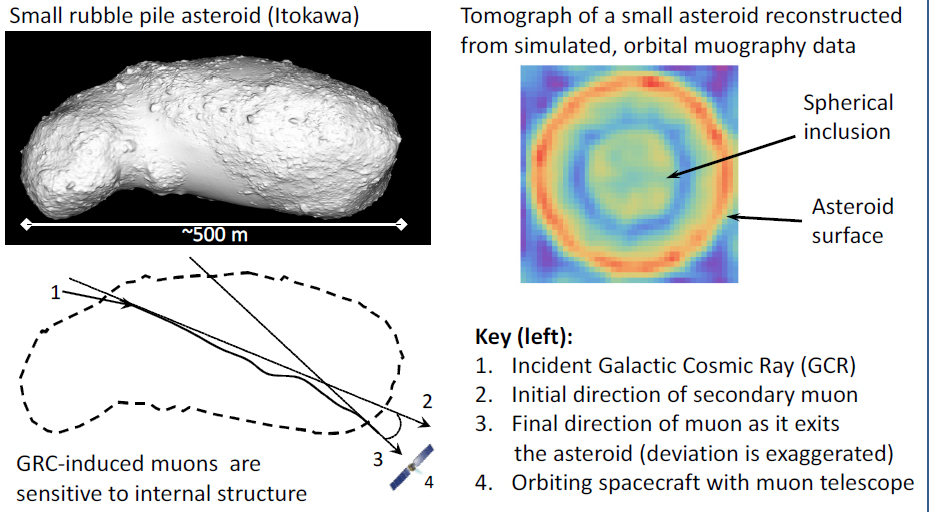Thomas Prettyman
Planetary Science Institute
Description
We will investigate the use of galactic cosmic ray (GCR) secondary particles to probe the deep interiors of small solar system bodies(SSBs), including comets, asteroids, and geologic structures on the surfaces of airless bodies. Our Phase I study demonstrated that muons, the long-range charged component of GCR showers, can penetrate SSBs on the order of a km in diameter or less, providing information on their interior structure. Muons produced in Earth’s atmosphere have been applied to image the interior of large objects, such as the Great Pyramids and volcanos. In Phase I, we found that the production of muons in the solid surfaces of airless bodies is much smaller than in Earth’s atmosphere. Nevertheless, the flux of transmitted muons is sufficient to detect inclusions within an asteroid or comet in a reasonable period of time, ranging from hours to weeks, depending on the size of the SSB and the density contrast, position and size of the inclusion. The intrinsic spatial resolution of muon radiography (“muography”) is on the scale of a few meters. The spatial resolution that can be achieved in practice depends on signal intensity and integration time, the angular resolution of the muon tracker (hodoscope) and details of data reduction and analysis methodology. Our Phase II project will continue to assess remaining unknowns for the application of muography to determining the interior structure of SSBs, assess risks for implementation, and provide a roadmap for development of SSB muography beyond the NIAC program. To achieve our objectives, we will work on four interrelated tasks: Signal and background characterization: Characterize the production and transmission of muons and secondary particle backgrounds made by cosmic ray showers in SSBs; Imaging studies: Develop methods to determine the density structure of SSB interiors and near-surface features from radiographic and tomographic data; Instrument design: Using simulations and bench-top laboratory experiments, investigate specific concepts for the design of compact hodoscopes that can be deployed on a spacecraft or in situ; Synthesis: Determine the range of applicability of the concept, identify the steps needed for maturation of the concept, and explore concepts for a pilot muography mission. Successful implementation of SSB muography requires a thorough understanding of muon production and transmission as well as sources of background. Phase I demonstrated that muon production is sensitive to the density of the top-most meter of the regolith. Thus, unknown variations in regolith density may obscure interior structure. Limb imaging of muons and the use of radar data to remotely map near-surface density will be explored as possible ways to mitigate variations in muon production. A compact, inexpensive system that could be deployed on a spacecraft or in situ appears to be feasible and warrants further study. A successful design must be capable of separately measuring the transmitted muon signal from the primary GCRs and secondary particles that scatter into the field-of-view of the hodoscope. This can be accomplished, for example, using Cherenkov radiators to reject lower energy scattered particles and to determine particle direction. Concepts for imaging systems identified in Phase I will be scrutinized. Phase II will be carried out by a multidisciplinary project team with broad experience in cosmic ray physics, remote sensing, meteoritics and planetary science. While the development of muography for SSBs is risky, the potential benefits are significant. There are presently no established methods to directly characterize the interior structure and macroporosity of an asteroid or comet. Muography could provide a direct and cost-effective means of probing the interior density structure. Such information is important for planetary science, in situ resource utilization, mining, and planetary defense.




























